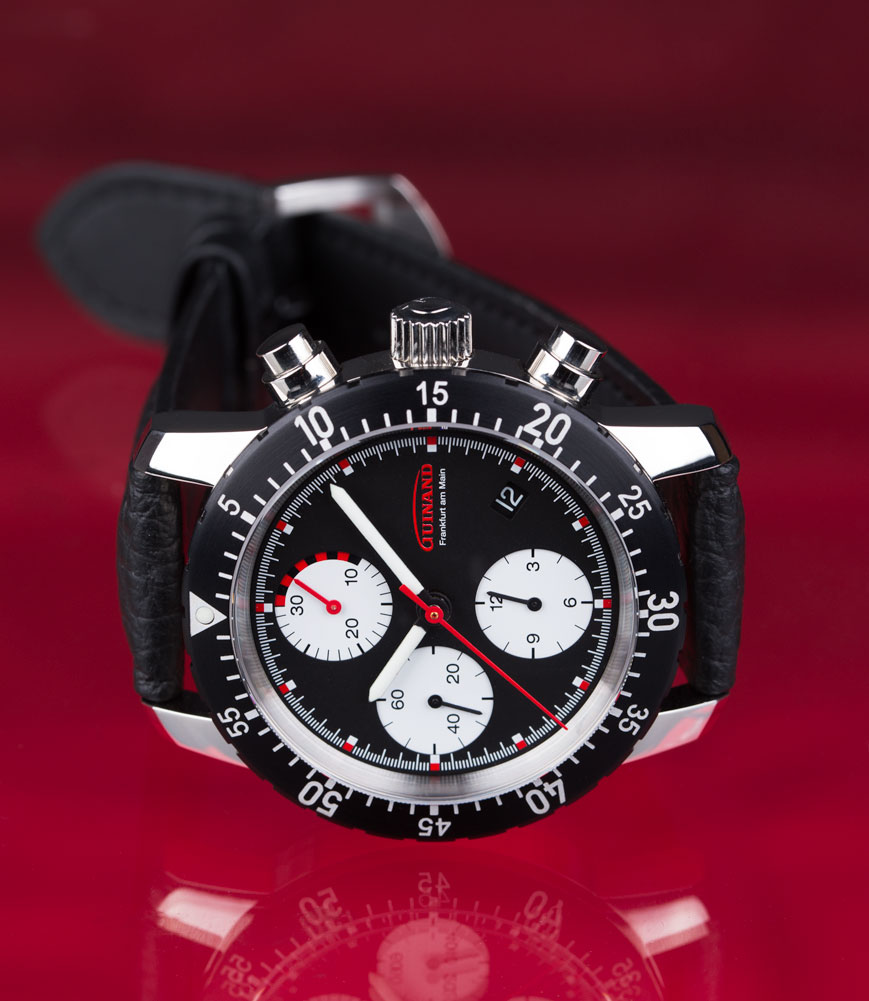HS100
Our HS100 model pays homage to the late 1960s/early 1970s and a pilot chronograph from that era designed by Helmut Sinn. We have carefully updated that model and released it in a limited edition of 100 items. With a date display at 4 O’clock and an automatic movement, the HS100 is state-of-the-art. The watch still boasts the little white subdials with the characteristic colour of the hands and the striking red and white zebra design of the minute scale. The face is protected by a domed, anti-reflecting sapphire crystal. The limited edition number “XXX of 100”, as well as the model designation, are engraved between the lugs. This watch is also made by us in Germany and, to distinguish it from the old models which were originally produced in Switzerland, “Guinand Frankfurt am Main” is engraved on its face.
Technical details
Special Features
- Face design based on a model by Helmut Sinn from the 1970s, case design practically unchanged, but function adapted to suit modern requirements
- Limited to 100 items, engraving of the limited edition number “XXX of 100” between the lugs at 6 O’clock
- Intricately designed two-part face with recessed faces for the white printed subdials
- Date display at 4 o’clock
- Light metal pilot bezel with bidirectional rotation
- Illuminated hands and indices Movement
Movement
- ETA/Valjoux 7750 calibre
- Automatic chronograph movement
- Chronograph mechanism integrated in the movement
- 28,800 semi-oscillations an hour
- Swiss beat setting Stop-second
- Shock proof in accordance with DIN 8308
- Anti-magnetic in accordance with DIN 8309
- Power reserve of approx. 40 hours
- Decorated mechanism, blued screws, Guinand-engraved rotor Functions
Functions
- Hour, minute, second
- Chronograph with 30-minute and 12-hour counter and large stop-second
- Date display
Case
- Polished stainless steel case
- Domed sapphire crystal, anti-reflecting on the inside
- Screwed back with a sapphire crystal
- Screwed crown, double sealed
- Protected chronograph pushers with double O-ring seals
- Water resistant, vacuum proof and pressure resistant up to 20 bar Dimensions and weight
Dimensions and Weight
- Case diameter: 40.6 mm
- Total height in the middle of the watch: 15.8 mm
- Band lug width: 20 mm
- Lug to lug: 48.4 mm
- Dimensions from spring bar to spring bar: 45.4 mm
- Weight without strap: 86.5 grams

Aviation pioneer
Helmut Sinn was a passionate flight instructor and rally driver before he founded his own watch company in the mid-1950s with the same dynamism and determination. There is no question that right from the start he lastingly shaped the market for pilot watches in Germany with his often unusual and innovative ideas. His ideas continued even after the sale of his company in 1994. Consequently, after a short break, he recommenced the manufacture of watches, under the brand names Chronosport and Guinand, in his chosen home of Frankfurt am Main. From the outset, professional users such as pilots, but also watch lovers with a passion for engineering, have always ranked among Helmut Sinn’s loyal fans.
The pilot watches (mainly chronographs) designed by Helmut Sinn are defined by precision and clarity. Due to his practical experience as a pilot and race car driver, this was particularly important to him. The red hands and the red and white zebra design of the HS100’s stop-second scale reflect this philosophy and ensure excellent readability of the stopwatch function.

1960s
The 1960s is when automatic watches started to gain popularity. Wrist watches were becoming both more accepted for everyday wear, and on the other hand more elegant. When it came to the case material corrosion-resistant and sturdy stainless steel was slowly becoming more popular than brass thanks to the progress of manufacturing technology. Cases were becoming much more robust without losing their classic round shape. This didn’t happen until the 1970s when some of the more daring case designs came out.
Chronographs still featured manual winding movements. The automatic movements were initially unable to satisfy the technical complexity of chronographs. This is why chronographs were still fitted with the traditional manual winding movements in the 1960s. Chronographs were increasingly produced with stainless steel cases, and were often given contrasting faces and hands, with stop watch counters in a contrasting colour. Not until the beginning of the 1970s did automatic movements truly experience their breakthrough, for instance with the legendary Valjoux 7750 automatic movement.
Our HS100 is based on a timepiece from this era. With its mechanical manual winding chronograph movement, the water resistant stainless steel case and the very readable face, it was considered state-of-the-art. The HS100 anniversary model pays homage to the typical style elements of the 1960s, but also combines these with modern watchmaking technology.








